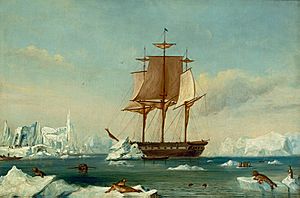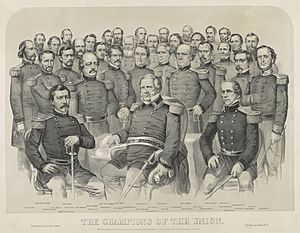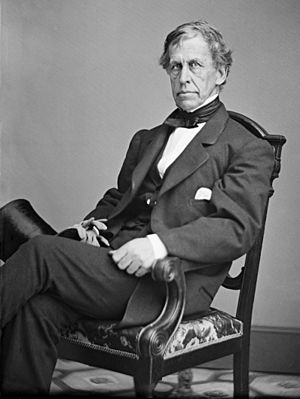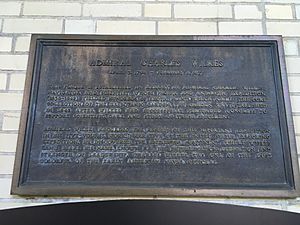Charles Wilkes facts for kids
Quick facts for kids
Charles Wilkes
|
|
|---|---|
 |
|
| Born | April 3, 1798 New York City, U.S.
|
| Died | February 8, 1877 (aged 78) Washington, D.C., U.S.
|
| Known for | |
| Military career | |
| Allegiance | |
| Branch | United States Navy |
| Years | 1818–1866 |
| Rank | Rear Admiral |
| Commands held |
|
| Wars | American Civil War |
| Signature | |
Charles Wilkes (April 3, 1798 – February 8, 1877) was an American naval officer, ship's captain, and explorer. He led the United States Exploring Expedition, 1838-1842. His behavior led to two convictions by court-martial, one stemming from the massacre of almost 80 Fijians on Malolo in 1840. During the American Civil War (1861–1865) he commanded USS San Jacinto during the Trent Affair, where he stopped a Royal Mail Ship and removed two British subjects, which almost led to war between the US and the UK.
Contents
Early life and career
Wilkes was born in New York City, on April 3, 1798, as the great nephew of the former Lord Mayor of London John Wilkes. His mother was Mary Seton, who died in 1802 when Charles was just three years old. As a result, Charles was raised by his aunt, Elizabeth Ann Seton, who would later convert to Roman Catholicism and become the first American-born woman canonized a saint by the Catholic Church. When Elizabeth was left widowed with five children, Charles was sent to a boarding school, and later attended Columbia College, which is the present-day Columbia University. He entered the United States Navy as a midshipman in 1818, and became a lieutenant in 1826.
In 1833, for his survey of Narragansett Bay, he was placed in charge of the Navy's Department of Charts and Instruments, out of which developed the Naval Observatory and Hydrographic Office. Wilkes' interdisciplinary expedition (1838–1842) set a physical oceanography benchmark for the office's first superintendent Matthew Fontaine Maury.
Columbian Institute
During the 1820s, Wilkes was a member of the prestigious Columbian Institute for the Promotion of Arts and Sciences, which counted among its members presidents Andrew Jackson and John Quincy Adams and many prominent men of the day, including well-known representatives of the military, government service, medical and other professions.
South Seas expedition
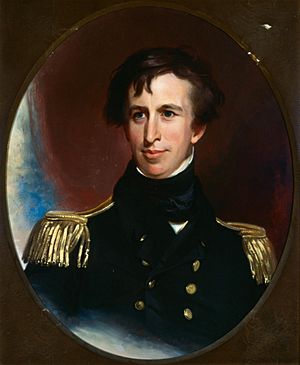
In 1838, although not yet a seasoned naval line officer, Wilkes was experienced in nautical survey work, and was working with civilian scientists. Upon this background, he was given command of the government exploring expedition "... for the purpose of exploring and surveying the Southern Ocean,... as well to determine the existence of all doubtful islands and shoals, as to discover, and accurately fix, the position of those which [lay] in or near the track of our vessels in that quarter, and [might] have escaped the observation of scientific navigators." The US Exploring Squadron was authorized by act of the Congress on May 18, 1836.
The Exploring Expedition, commonly known as the "Wilkes Expedition," included naturalists, botanists, a mineralogist, taxidermists, artists and a philologist, and it was carried by USS Vincennes (780 tons) and USS Peacock (650 tons), the brig USS Porpoise (230 tons), the store-ship USS Relief, and two schooners, USS Sea Gull (110 tons) and USS Flying Fish (96 tons).
Departing from Hampton Roads on August 18, 1838, the expedition stopped at the Madeira Islands and Rio de Janeiro; visited Tierra del Fuego, Chile, Peru, the Tuamotu Archipelago, Samoa, and New South Wales; from Sydney sailed into the Antarctic Ocean in December 1839 and reported the discovery "of an Antarctic continent west of the Balleny Islands" of which it sighted the coast on January 25, 1840. After charting 1500 miles of Antarctic coastline, the expedition visited Fiji and the Hawaiian Islands. In Fiji, the expedition kidnapped the chief Ro Veidovi, charging him with the murder of a crew of American whalers. And, in July 1840, two sailors, one of whom was Wilkes' nephew, Midshipman Wilkes Henry, were killed while bartering for food on Fiji's Malolo Island. Wilkes' retribution was swift and severe. According to an old man of Malolo Island, nearly 80 Fijians were killed in the incident.
From December 1840 to March 1841, he employed hundreds of native Hawaiian porters and many of his men to haul a pendulum to the summit of Mauna Loa to measure gravity. Instead of using the existing trail, he blazed his own way, taking much longer than he anticipated. The conditions on the mountain reminded him of Antarctica. Many of his crew suffered snow blindness, altitude sickness and foot injuries from wearing out their shoes.
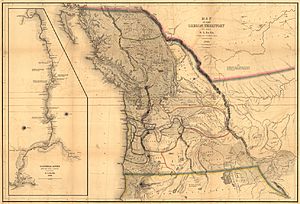
He explored the west coast of North America, including the Strait of Juan de Fuca, Puget Sound, the Columbia River, San Francisco Bay and the Sacramento River, in 1841.
He held the first American Independence Day celebration west of the Mississippi River in Dupont, Washington on July 5, 1841.
The United States Exploring Expedition passed through the Ellice Islands and visited Funafuti, Nukufetau and Vaitupu in 1841. The expedition returned by way of the Philippines, the Sulu Archipelago, Borneo, Singapore, Polynesia and the Cape of Good Hope, reaching New York on June 10, 1842.
After having completely encircled the globe (his was the last all-sail naval mission to do so), Wilkes had logged some 87,000 miles and lost two ships and 28 men. Wilkes was court-martialled upon his return for the loss of one of his ships on the Columbia River bar, for the regular mistreatment of his subordinate officers, and for excessive punishment of his sailors. A major witness against him was ship doctor Charles Guillou. He was acquitted on all charges except illegally punishing men in his squadron. For a short time, he was attached to the Coast Survey, but from 1844 to 1861, he was chiefly engaged in preparing the report of the expedition.
His Narrative of the United States Exploring Expedition (5 volumes and an atlas) was published in 1844. He edited the scientific reports of the expedition (19 volumes and 11 atlases, 1844–1874) and was the author of Vol. XI (Meteorology) and Vol. XXIII (Hydrography). Alfred Thomas Agate, engraver and illustrator, was the designated portrait and botanical artist of the expedition. His work was used to illustrate the Narrative of the United States Exploring Expedition.
The Narrative contains much interesting material concerning the manners, customs, political and economic conditions in many places then little known. Wilkes' 1841 Map of the Oregon Territory pre-dated John Charles Fremont's first Oregon Trail pathfinder expedition guided by Kit Carson during 1842.
Other valuable contributions were the three reports of James Dwight Dana on Zoophytes (1846), Geology (1849) and Crustacea (1852–1854). Moreover, the specimens and artifacts brought back by expedition scientists ultimately formed the foundation for the Smithsonian Institution collection. In addition to many shorter articles and reports, Wilkes published the major scientific works Western America, including California and Oregon in 1849, and Theory of the Winds in 1856.
Civil War
Wilkes was promoted to the rank of commander in 1843 and that of captain in 1855. At the outbreak of the American Civil War, he was assigned to the command of USS San Jacinto to search for the Confederate commerce destroyer CSS Sumter.
Trent Affair
As part of these duties he visited the British colony of Bermuda. Acting on orders, Wilkes remained in port for nearly a week aboard his flagship, USS Wachusett, violating the British rule that allowed American naval vessels (of either side) to remain in port for only a single day. While Wilkes remained in port, his gunboats USS Tioga and USS Sonoma blockaded Saint George's harbor, a key Confederate blockade runner base. The gunboats opened fire at the Royal Mail Ship Merlin.
When Wilkes learned that James Murray Mason and John Slidell, two Confederate commissioners to England, were bound for England on a British packet boat, RMS Trent, he ordered the steam frigate San Jacinto to stop them. On November 8, 1861, San Jacinto met Trent and fired two shots across its bow, forcing the ship to stop. A boarding party from San Jacinto led by its captain then boarded Trent and arrested Mason and Slidell. The diplomats were taken to Fort Warren in Boston Harbor.
The actions of "The Notorious Wilkes," as Bermuda media branded him, convinced many that full-scale war between the United States and the United Kingdom was inevitable.
He was officially thanked by Congress "for his brave, adroit and patriotic conduct". However, his action was later disavowed by President Lincoln due to diplomatic pressure by the British Government (Mason and Slidell were released). His next service was in the James River flotilla and he was placed on the retired list on December 21, 1861. Subsequently, after reaching the rank of commodore on July 16, 1862, he was assigned to duty against blockade runners in the West Indies.
Later life
Some historians speculate that Wilkes' obsessive behavior and harsh code of shipboard discipline shaped Herman Melville's characterization of Captain Ahab in Moby-Dick. Such speculation is not mentioned in the U.S. Naval historical archives.
In addition to his contribution to U.S. Naval history and scientific study in his official Narrative of the Exploration Squadron (6 volumes), Wilkes wrote his autobiography.
Wilkes died in Washington, DC, with the rank of Rear Admiral.
In August 1909, the United States moved his remains to Arlington National Cemetery. His gravestone says that "he discovered the Ant-arctic continent."
Legacy
The US Navy named four ships for Wilkes: torpedo boat USS Wilkes (TB-35) served around the turn of the 20th century, destroyer USS Wilkes (DD-67) served during World War I, and destroyer USS Wilkes (DD-441) served during World War II. An oceanographic survey vessel, USS Wilkes (T-AGS-33), was launched in 1969, sponsored by Mrs. Hollis Lyons Joy (Deborah Wilkes Joy), Wilkes' great granddaughter.
Wilkes Land in Antarctica is named after him.
In 1923, Wilkes Island, one of the three islands surrounding the lagoon at Wake Atoll was named for Wilkes by Alexander Wetmore, lead scientist of the Tanager Expedition.
Captain Charles Wilkes Elementary in Bainbridge Island, Washington is his namesake.
Wilkes Boulevard in Columbia, Missouri is named in his honor, as is the Hawaiian plant genus Wilkesia.
Dates of rank
- Midshipman - 1 January 1818
- Lieutenant - 28 April 1826
- Commander - 13 July 1843
- Captain - 14 September 1855
- Retired List, 21 December 1861
- Commodore, Retired List - 16 July 1862
- Rear Admiral, Retired List - 6 August 1866
See also
 In Spanish: Charles Wilkes para niños
In Spanish: Charles Wilkes para niños


